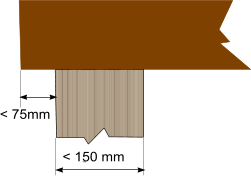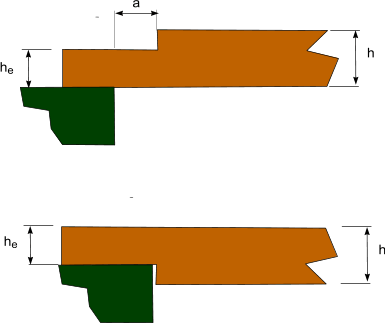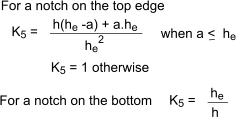Introduction
The timber calculations reviewed in the timber design pages on this
website are based on BS EN 5288 Part 2. This standards includes modification
factors used to allow for operating conditions and loading scenarios. This page
provides some guidance in assessing these factors
Relevant Standards..For comprehensive list of standards Wood related Standards
BS 5268 -2 ;2002 Structural use of timber � Part 2: Code of practice for permissible
stress design, materials and workmanship.
Modifying factors
K2 by which stresses and moduli for service classes
1 and 2 should be multiplied to obtain stresses and modulii applicable to service class 3
K3 for duration of loading
K4 for bearing stress
K5 for notched beams
K6 for shapes other than rectangular
K7 width factor for bending stresses for widths other than 300mm
K8 for load sharing applications
K9 used to modify the minimum modulus of elasticity for trimmer joists and lintels
K12 for compression members
K13 for the effective length of spaced columns
K14 width factor for tensile loaded members for widths other than 300mm
K15, K16, K17, K18, K19 and K20 for single grade glued laminated members and horizontally
K27, K28 and K29 for vertically glued laminated members
K30, K31 and K32 for individually designed glued end joints in horizontally glued laminated members
|
Information on correction factors
K2
Modification factor, K2, by which stresses and moduli for service classes 1 and 2
should be multiplied to obtain stresses and moduli applicable to service class 3.
Note:.. The properties provided in BS 5368:2007 for the different timbers are generally applicable to Service class 1 & 2. Please refer to notes on service class Service Class
| Property | Value of K2 |
Bending parallel to grain | 0,8 |
Tension parallel to grain | 0,8 |
Compression paralle to grain | 0,6 |
Compression parallel to grain | 0,6 |
Shear parallel to grain | 0,9 |
Mean & Min Modulus of Elasticiy | 0,8 |
K3
| Duration of Load | Value of K3 |
Long Term (e.g.permanently imposed ) | 1,00 |
Medium term (e.g. dead + temporary imposed | 1,25 |
Short Term (e.g. dead + imposed + wind | 1,5 |
Very short term (e.g. dead + wind | 1,75 |
K4
The grade stresses for compression perpendicular to the grain apply to
bearings of any length at the ends of a member, and bearings 150 mm or more in length at any position.
However for bearings less than 150 mm long located 75 mm or more from the end of a member, as shown in figure belwo
thee grade stress should be multiplied by the modification factor, K4

| length of Bearing | Value of K4 |
10 | 1,74 |
15 | 1,67 |
25 | 1,53 |
40 | 1,33 |
50 | 1,20 |
75 | 1,14 |
100 | 1,10 |
150+ | 1,00 |
K5
This factor is applied for members taking load at notched ends as shown below


K6
Grade bending stresses primarily apply to solid timber members of rectangular cross-section.
For other shapes of cross-section the grade bending stresses should be multiplied by the modification factor, K6, where
K6 = 1.18 for solid circular sections;
K6 = 1.41 for solid square sections loaded on a diagonal.
|
K7
The grade bending stresses provided in the tables is generally based on sections 300mm deep a
constant (K7)is used when other thicknesses are used.

K8
In construction applications where four or more members are sharing
the imposed load e.g. rafters , joists, trusses etc. with suitable provisions for distributing
the load e.g. boarding, battens etc the admissibles stresses and the modulus shoul be obtained using the following
rules .
- The appropriate grade stresses should be multiplied by the
load sharing modification factor, K8 = 1.1.
- The mean modulus of elasticity should be used to calculate deflections and displacements under both
dead and imposed load. However if the loading results from mechanical plant and
equipment, for storage, or for floors subject to vibrations, then the minimum modulus of elasticity should be used.
|
K9
The members which are sharing the load, as described above, the minimum modulus of elasticity hould be
modified by the factor, K9, when calculating the deflection deflections
| No Pieces |
Value of K9 |
| Softwoods | Hardwoods |
| 1 | 1,00 | 1,00 |
| 2 | 1,14 | 1,06 |
| 3 | 1,21 | 1,08 |
| 4 or more | 1,24 | 1,10 |
K14
The grade compressive stress listed in the tables are based on a width of 300mm. For timber members of other
sizes a factor K14 should be used.
K14 = 1,17 for solid timber with a width less than 72mm
K14 = (300 h.)0,11 for solid members having a width h greater than 72mm
K15,K16,K17K18,K19,K19
Modifcation factors for horizontally glued single grade laminates
| Strength Class | Number of Laminations |
Bending Parallel
to Grain | Tension parallel to grain |
Compression parallel to grain | Compression normal to grain |
Shear parallel to grain> | Modulus of Elasticity |
| K15 | K16 | K17 | K18K19K20
C27,C30,C35, C40
D50,D60,D70 | 4 or More | 1,1 | 1,1 | 1,04 | 1,49 | 1,49 | 1,00 |
C16,C18,C22, C24
D30,D35,D40 | 4 | 1,26 | 1,26 | 1,04 | 1,55 | 2,34 | 1,07 |
| 5 | 1,34 | 1,34 |
| 7 | 1,39 | 1,39 |
| 10 or more | 1,42 | 1,42 |
| | |
K27,K28,K29
Modification factors for vertically glued single grade laminates
| Number of laminations | Bending, Tension and shear parallel to grain
K27
|
Mod of elasticity and compression parallel to grain
K28 | Compression normal to grain
K29 |
| Softwoods | Hardwoods | Softwoods | Hardwoods | Softwoods and Hardwoods |
| 2 | 1,11 | 1,06 | 1,14 | 1,06 | 1,10
| | 3 | 1,16 | 1,08 | 1,21 | 1,08 | 1,10
| | 4 | 1,19 | 1,10 | 1,24 | 1,10 | 1,10
| | 5 | 1,21 | 1,11 | 1,27 | 1,11 | 1,10
| | 6 | 1,23 | 1,12 | 1,29 | 1,12 | 1,10
| | 7 | 1,24 | 1,12 | 1,30 | 1,12 | 1,10
|
K30,K31,K32
| Timber | Bending, parallel to grain |
Tension, parallel to grain |
Compression, parallel to grain |
| K28 | K31 | K32 |
| Softwood | 1,63 | 1,63 | 1,43 |
| Hardwood | 1,32 | 1,32 | 1,42 |
|



